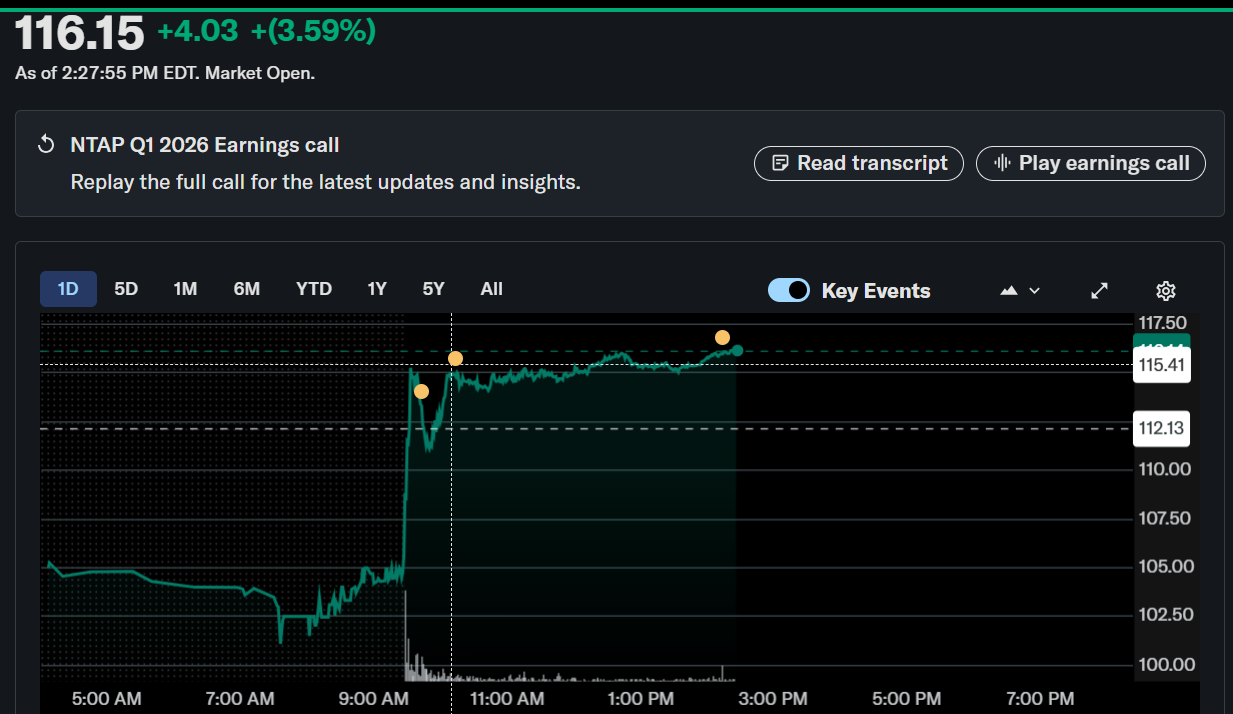NetApp Inc. ($NTAP) Stock: Q1 2026 Earnings and All-Flash Growth
TLDR
- Q1 revenue reached $1.56 billion, up 1% YoY, beating expectations.
- All-flash array revenue rose 6% to $893 million, securing #1 market share.
- Public cloud services grew 33% YoY excluding Spot.
- Record cash flow from operations hit $673 million, free cash flow $620 million.
- Shares dropped 6% after a cautious Q2 outlook.
NetApp Inc. (NASDAQ: NTAP) closed its first quarter of fiscal 2026 with revenue growth and all-flash leadership, yet shares fell nearly 6% in extended trading as guidance suggested slower spending ahead. As of August 27, 2025, the company reported Q1 results with revenue at $1.56 billion, up 1% year over year, while investors weighed market headwinds against operational strength. As of writing, shares trade at $114.26, up 1.90%.
NetApp, Inc. (NTAP)
Quarterly Financial Performance
NetApp’s Q1 fiscal 2026 revenue of $1.56 billion surpassed analyst expectations of $1.55 billion. All-flash array revenue rose 6% year over year to $893 million, giving the company the top position in the all-flash market. Hybrid cloud revenue increased 1% to $1.40 billion, while public cloud revenue reached $161 million, also up 1% year over year but 18% growth when excluding Spot.
The company recorded a gross margin of 71.1%, improving 1.6 percentage points sequentially. Operating profit was $401 million with a margin of 25.7%. Non-GAAP diluted EPS came in at $1.55, while GAAP EPS was $1.15. Deferred revenue climbed 9% to $4.53 billion.
NetApp also returned $404 million to shareholders, including $300 million in buybacks and $104 million in dividends, or $0.52 per share. Cash and short-term investments totaled $3.3 billion, against $2.5 billion in debt, resulting in a net cash position of $840 million.
Guidance and Outlook
For Q2 fiscal 2026, NetApp expects revenue between $1.615 billion and $1.765 billion, with the midpoint slightly above consensus estimates of $1.68 billion. Adjusted EPS is projected between $1.84 and $1.94. For the full year, NetApp reaffirmed revenue guidance of $6.63 billion to $6.88 billion, with adjusted EPS expected in the range of $7.60 to $7.90.
Despite cautious guidance, management pointed to strong demand for AI-ready infrastructure and expanding partnerships with hyperscalers, including AWS, Google Cloud, and Microsoft Azure.
Strategic Highlights
The quarter was marked by significant innovation and partnerships. NetApp introduced its AIPod Mini with Intel, advancing AI adoption across industries. It also launched cyber-resilience features to address emerging threats and introduced BlueXP Keystone Management for subscription optimization.
In collaboration with NVIDIA and Microsoft, NetApp unveiled enterprise-grade RAG architecture and cloud integrations, strengthening its positioning in AI-driven data solutions. Awards and recognition reinforced its leadership, including being named #1 in all-flash storage by IDC and inclusion on the Forbes Global 2000 list.
Market Performance
Despite the operational achievements, NTAP shares declined after the earnings release. Year-to-date, the stock is nearly flat at -0.07%, while the S&P 500 gained 10.08%. Over one year, shares are down 11.7%, but the company has delivered strong long-term performance, with a three-year return of 63.6% and a five-year return of 183.5%, far outpacing the broader market.
NetApp’s leadership in all-flash and AI-ready infrastructure supports its long-term growth potential, though short-term revenue pressures remain a challenge.
The post NetApp Inc. ($NTAP) Stock: Q1 2026 Earnings and All-Flash Growth appeared first on CoinCentral.
You May Also Like

Chinese Bitcoin Hardware Titans Control 95% of Market, Now Coming to America to Dodge Trump Tariff War

Trump slams Powell’s rate stance as BTC price flatlines
